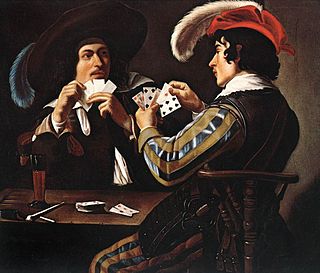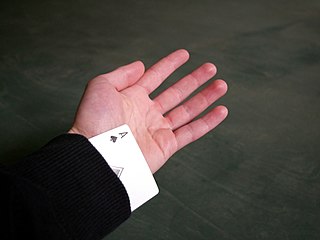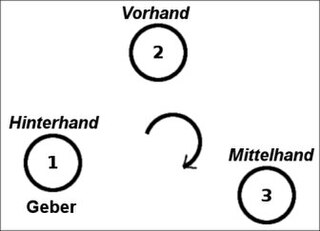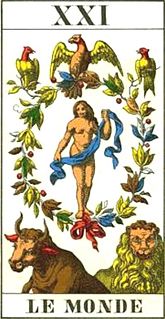
A card game is any game using playing cards as the primary device with which the game is played, be they traditional or game-specific.

Let It Ride is a casino table game based on poker, where the player wagers on a five-card poker hand formed by their own three cards and two community cards. It is a product of Bally Technologies, under its Shuffle Master brand.

Cheating in poker is any behavior outside the rules that is intended to give an unfair advantage to one or more players.

Card players are those participating in a card game. Various names are given to card players based on their role or position.

Card counting is a casino card game strategy used primarily in the blackjack family of casino games to determine whether the next hand is likely to give a probable advantage to the player or to the dealer. Card counters are a class of advantage players, who attempt to decrease the inherent casino house edge by keeping a running tally of all high and low valued cards seen by the player. Card counting allows players to bet more with less risk when the count gives an advantage as well as minimize losses during an unfavorable count. Card counting also provides the ability to alter playing decisions based on the composition of remaining cards.
Rubber bridge is a form of contract bridge played by two competing pairs using a particular method of scoring. A rubber is completed when one pair becomes first to win two games, each game presenting a score of 100 or more contract points; a new game ensues until one pair has won two games to conclude the rubber. Owing to the availability of various additional bonus and penalty points in the scoring, it is possible, though less common, to win the rubber by amassing more total points despite losing two games out of three. Rubber bridge involves a high degree of skill but there is also a fair amount of luck involved in who gets the best cards.

Three Card Poker is a casino table game based on poker.

Laurens Hammond, was an American engineer and inventor. His inventions include, most famously, the Hammond organ, the Hammond clock, and the world's first polyphonic musical synthesizer, the Novachord.

In duplicate bridge, a board is an item of equipment that holds one deal, or one deck of 52 cards distributed in four hands of 13 cards each. The design permits the entire deal of four hands to be passed, carried or stacked securely with the cards hidden from view in four pockets. This is required for duplicate bridge tournaments, where the same deal is played several times and so the composition of each hand must be preserved during and after each play of each deal.
A shuffling machine is a machine for randomly shuffling packs of playing cards.

Craits is a shedding card game for two to five players. It was invented in the 1970s in Cambridge, Massachusetts, and is derived from Crazy Eights, which forms the origin of its name.

Tonk, or tunk, is a matching card game, which combines features of knock rummy and conquian. Tonk is a relatively fast-paced game that can be played by 2-4 players. It was popular with blues and jazz musicians in southern Louisiana in the 1930s, including Duke Ellington's orchestra, and was played during breaks in the back rooms of bars and saloons. In many other places it has become a popular pastime for workers while on their lunch breaks. It can be played for just points or for money wagered.
Goulash is a style of playing the card game of bridge, normally in friendly play such as rubber bridge, in which the cards are not thoroughly shuffled between consecutive deals. The aim is to create deals where the suits are more unevenly distributed between the players, thus creating "wild" deals in order to make the game more vivid.
A poker dealer distributes cards to players and manages the action at a poker table.
304, pronounced three-nought-four, is a trick-taking card game popular in Sri Lanka, coastal Karnataka, Tamil Nadu and Maharashtra, in the Indian sub continent. The game is played by two teams of two using a subset of the 52 standard playing cards.

Troccas is a member of the Tarot family of card games. It is played in the Romansh speaking part of the canton Grisons of Switzerland. It is not known exactly how this game entered Switzerland but it is generally thought to have arrived from Italy during the 17th century.
The Hammond Clock Company of Chicago, Illinois, produced electric clocks between 1928 and 1941. It was one of the ventures of Laurens Hammond, the inventor of the famous Hammond organ.

The following is a glossary of terms used in card games. Besides the terms listed here, there are thousands of common and uncommon slang terms. This list does not encompass terms that are specific to one game.
A misdeal in card games is an error by the dealer which calls for a re-deal and/or a penalty. The rules for a misdeal and penalty vary according to the game. A misdeal is sometimes called by miscounting, or when two cards stick together. Sometimes, when a misdeal is detected, a new hand is dealt. In most games a misdeal, and recall of the cards, does not prevent the same player dealing again.

Lupfen is a card game for 3–5 players that is played mainly in west Austria and south Germany, but also in Liechtenstein. The rules vary slightly from region to region, but the basic game in each variation is identical. It is one of the Rams group of card games characterised by allowing players to drop out of the current game if they think they will be unable to win any tricks or a minimum number of tricks.















